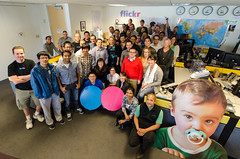Compass is a great thing. At Flickr, we’re actually quite smitten with it. But being conscious of your friends’ friends is important (you never know who they’ll invite to your barbecue), and we’re not so sure about this “Ruby” that Compass is always hanging out with. Then there’s Ruby’s friend Bundler who, every year at the Christmas Party, tells the same stupid story about the time the police confused him with a jewelry thief. Enough is enough! We’ve got history, Compass, but we just feel it might be time to try seeing other people.
Solving for Sprites
In order to find a suitable replacement (and for a bit of closure), we had to find out what kept us relying on Compass for so long. We knew the big one coming in to this great experiment: sprites. Flickr is a huge site with many different pages, all of which have their own image folders that need to be sprited together. There are a few different options for compiling sprites on your own, but we liked spritesmith for its multiple image rendering engines. This gives us some flexibility in dependencies.
A grunt task is available for spritesmith, but it assumes you are generating only one sprite. Our setup is a bit more complex and we’d like to keep our own sprite mixin intact so we don’t actually have to change a line of code. With spritesmith and our own runner to iterate over our sprite directories, we can easily create the sprites and output the dimensions and urls via a simple Handlebars template to a Sass file.
{{#each sprites}}
{{#each images}}
%{{../dir}}-{{name}}-dimensions {
width: {{coords.width}}px;
height: {{coords.height}}px;
}
%{{../dir}}-{{name}}-background {
background: image-url('{{../url}}') -{{coords.x}}px -{{coords.y}}px no-repeat;
}
{{/each}}
{{/each}}
You could easily put all three of these rules in the same declaration, but we have some added flexibility in mind for our mixin.
It’s important to note that, because we’re using placeholders (the % syntax in Sass), nothing is actually written out unless we use it. This keeps our compiled CSS nice and clean (just like Compass)!
@import 'path/to/generated/sprite/file'
@mixin background-sprite($icon, $set-dimensions: false) {
@extend %#{$spritePath}-#{$icon}-background;
@if $set-dimensions == true {
@extend %#{$spritePath}-#{$icon}-dimensions;
}
}
Here, our mixin uses the Sass file we generated to provide powerful and flexible sprites. Note: Although retina isn’t shown here, adding support is as simple as extending the Sass mixin with appropriate media queries. We wanted to keep the example simple for this post, but it gives you an idea of just how extensible this setup is!
Now that the big problem is solved, what about the rest of Compass’s functionality?
Completing the Package
How do we account for the remaining items in the Compass toolbox? First, it’s important to find out just how many mixins, functions, and variables are used. An easy way to find out is to compile with Sass and see how much it complains!
sass --update assets/sass:some-temp-dir
Depending on the complexity of your app, you may see quite a lot of these errors.
error assets/css/base.scss (Line 3: Undefined mixin 'font-face'.)
In total, we’re missing 16 mixins provided by Compass (and a host of variables). How do we replace all the great mixin functionality of Compass? With mixins of the same name, node-bourbon is a nice drop-in replacement.
What is the point of all this work again?
The Big Reveal
Now that we’re comfortably off Compass, how exactly are we going to compile our Sass? Well try not to blink, because this is the part that makes it all worthwhile.
Libsass is a blazing-fast C port of the Sass compiler that exposes bindings to modules like node-sass.
Just how fast? With Compass, our compile times were consistently around a minute and a half to two minutes. Taking care of spriting ourselves and using libsass for Sass compilation, we’re down to 5 seconds. When you deploy as often as we do at Flickr (in excess of 10 times a day), that adds up and turns into some huge savings!
What’s the Catch?
There isn’t one! Oh, okay. Maybe there are a few little ones. We’re pretty willing to swallow them though. Did you see that compile time?!
There are some differences, particularly with the @extend directive, between Ruby Sass and libsass. We’re anticipating that these small kinks will continue to be ironed out as the port matures. Additionally, custom functions aren’t supported yet, so some extensibility is lost in coming from Ruby (although node-sass does have support for the image-url built-in which is the only one we use, anyway).
With everything taken into account, we’re counting down the days until we make this dream a reality and turn it on for our production builds.

